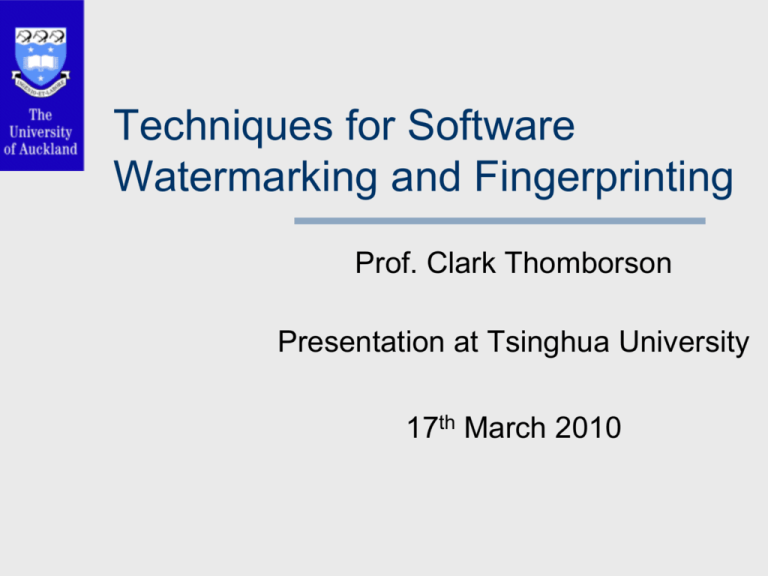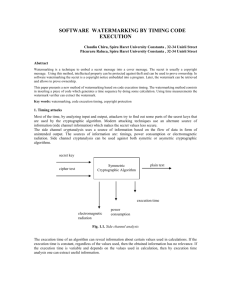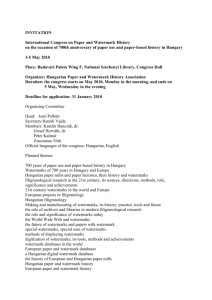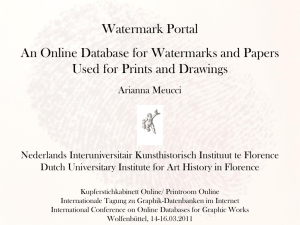SWWMandFPtechniques17Mar10
advertisement

Techniques for Software Watermarking and Fingerprinting Prof. Clark Thomborson Presentation at Tsinghua University 17th March 2010 A Small, Immature Field... This search was conducted on 15 March 2010. The number of citations was “about 12,500” in March 2008. Citations growing by 34%/year. 2 A Mature Field... This search was conducted on 15 March 2010. The number of citations was “about 559,000” in March 2008. Citations growing by 28%/year. 3 Watermarking and Fingerprinting Watermark: an additional message, embedded into a cover message. Messages may be images, audio, video, text, executables, … Visible or invisible (steganographic) embeddings Robust (difficult to remove) or fragile (guaranteed to be removed) if cover is distorted. Watermarking (only one extra message per cover) or fingerprinting (different versions of the cover carry different messages). Messages may be encrypted. Software Watermarking Techniques Key questions: Where is the watermark embedded? How is the watermark embedded? Who wants the watermark to be embedded? Why is the watermark embedded? What are its desired properties? When is the watermark embedded? When, where, and how can the watermark be extracted? 5 Software Watermarking Systems An embedder E(P; W; k) Pw embeds a message (the watermark) W into a program P using secret key k, yielding a watermarked program Pw An extractor R(Pw ; ... ) W extracts W from Pw In an invisible watermarking system, R (or a parameter) is a secret. In visible watermarking, R is well-publicised (ideally obvious). The attack set A and goal G model the security threat. For a robust watermark, the attacker’s goal G is typically a falsenegative extraction, using an attack a() A on a watermarked object Pw to create an attacked object a(Pw), with R(a(Pw); ... ) ≠ W such that a(Pw) has most or all of the original function of P. For a fragile watermark, the attacker’s goal is a false-positive: R(a(P); ... ) = W such that a(P) has similar functionality to Pw. A protocol attack is an r() A which behaves like an extractor, but delivers false-positive or false-negative results (depending on G). The attacker must substitute r() for the true extractor R in the response mechanism of the system. 6 Response Mechanisms A watermark extractor R() delivers a signal to a response system S. It’s easy to forget that M is necessary. S might be … A judge in a courtroom, in which case R must deliver forensically-sound evidence. A newspaper reporter, in which case R must be a believable source. A computerised access-control system, in which case R’s signal might cause an authorisation to be granted (or revoked). 7 Where Software Watermarks are Embedded Static code watermarks are stored in the section of the executable that contains instructions. Static data watermarks are stored in other sections of the executable Static watermarks are extracted without executing (or emulating) the code. A watermark extractor is a special-purpose static analysis. Extraction is inexpensive, but we don’t know of any highly robust static code watermarks. Attackers can easily modify the watermarked code to create an unwatermarked (false-negative) version. 8 Dynamic Watermarks Easter Eggs are revealed to any end-user who types a special input sequence. This is a robust watermark. Other dynamic, robust, watermarks: Execution Trace Watermarks are carried in the instruction execution sequence of a program, when it is given a special input sequence (possibly null). Data Structure Watermarks are built by a program, when it is given a special input. Data Value Watermarks are produced by a program on a surreptitious channel, when it is given a special input. 9 Easter Eggs The watermark is visible – if you know where to look! Not very robust, after the secret is published. See www.eeggs.com 10 11 Dynamic Data Structure Watermarks The embedder inserts code in the program, so that it creates a recognisable data structure when given specific input (the key). Details are given in our POPL’99 paper, and in two published patent applications. Assigned to Auckland UniServices Ltd. I am still trying to find a good use for this technology! Implemented at http://www.cs.arizona.edu/sandmark/ (2000- ) Experimental findings by Palsberg et al. (2001): JavaWiz adds less than 10 kilobytes of code on average. Embedding a watermark takes less than 20 seconds. Watermarking increases a program’s execution time by less than 7%. Watermark retrieval takes about 1 minute per megabyte of heap. 12 Thread-Based Watermarks A dynamic watermark is expressed in the thread-switching behaviour of a program, when given a specific input (the key). The thread-switches are controlled by non-nested locks. NZ Patent 533208, US Patent App 2005/0262490 Article in IH’04; Jas Nagra’s PhD thesis, 2006 The embedder inserts tamper-proofing sequences which closely resemble the watermark sequences but which, if removed, will cause the program to behave incorrectly. This is a “self-help” response system, integrated with the watermark. 13 Active Watermarks A watermark can be embedded during a design step (“active watermarking”: Kahng et al., 2001). IC designs may carry watermarks in place-route constraints. Register assignments during compilation can encode a software watermark, however such watermarks are insecure because they can be easily removed by an adversary. Most software watermarks are “passive”, i.e. inserted at or near the end of the design process. 14 Why Watermark Software? (Thomborson & Nagra, 2002) Invisible robust watermarks: useful for prohibition (of unlicensed use) Invisible fragile watermarks: useful for permission (of licensed uses). Visible robust watermarks: useful for assertion (of copyright or authorship). Visible fragile watermarks: useful for affirmation (of authenticity or validity). 15 The Fifth Function Any watermark is useful for the steganographic transmission of information irrelevant to security (espionage, humour, …). Transmission Marks can transmit “calls for help” to other systems. Useful in response mechanisms. 16 A Functional Taxonomy for Watermarks [2002/2010] Watermarks Protective Robust Non-protective Fragile Assertion Prohibition Affirmation Permission (Visible) (Invisible) (Visible) (Invisible) Transmission Overt (Visible) Covert (Invisible) Watermark: an additional message, embedded into a cover message or object. Non-protective: the watermark is more important than its cover. 17 Defense in Depth for Software 1. Prevention: a) Deter attacks on forbiddances (use obfuscation, encryption, robust watermarking, cryptographic hashes, or trustworthy computing). b) Deter attacks on allowances (use replication, resilient algorithms, fragile watermarking). 2. Detection: a) Monitor subjects (user logs), relative to a user ID. Use biometrics, ID tokens, or passwords. b) Monitor actions (execution logs, intrusion detectors), relative to a code ID: cryptographic hashing, code watermarking. c) Monitor objects (object logs), relative to an object ID: hashing, data watermarking. 3. Response: a) Ask for help: Set off an alarm (which may be silent – steganographic), then wait for an enforcement agent. b) Self-help: Self-destructive or self-repairing systems. 18 Use Cases We can find “use cases” for software watermarks at the dynamic layer of our framework. Use cases have an actor, a requested action (or set of actions), and a desired response from the system. Example: Clark seeks permission to read a DRM-protected document. Actor = Clark; action = read; desired response = permission. The DRM information might be held in a software watermark, and this watermark may contain a rule permitting this action. We can also look for “misuse cases”: malicious actors who take advantage of a system. A rule (of static security, i.e. a permission) is not a use. Misuse case: Pirate Pete seeks permission to read a document. Desired response: a forbiddance. Software watermarks have mostly been used for forbiddances. (I’ll explain why, later in this talk.) There are also “confuses” – authorised users who cause damage by mistake. Confuse cases should be forbidden. 19 Summary/Review 1. What is a watermark? 2. We should also ask: who, when, where, how, why? What is a watermarking system? 3. Embedders, extractors, and (don’t forget ;-) responders. How can we embed software watermarks? 4. Static or dynamic? Active or passive? Case study: thread-based watermarks. Why would anyone want to embed a watermark? Defense in depth Use, misuse, and confuse case analysis Functional analysis (a taxonomy) 20







